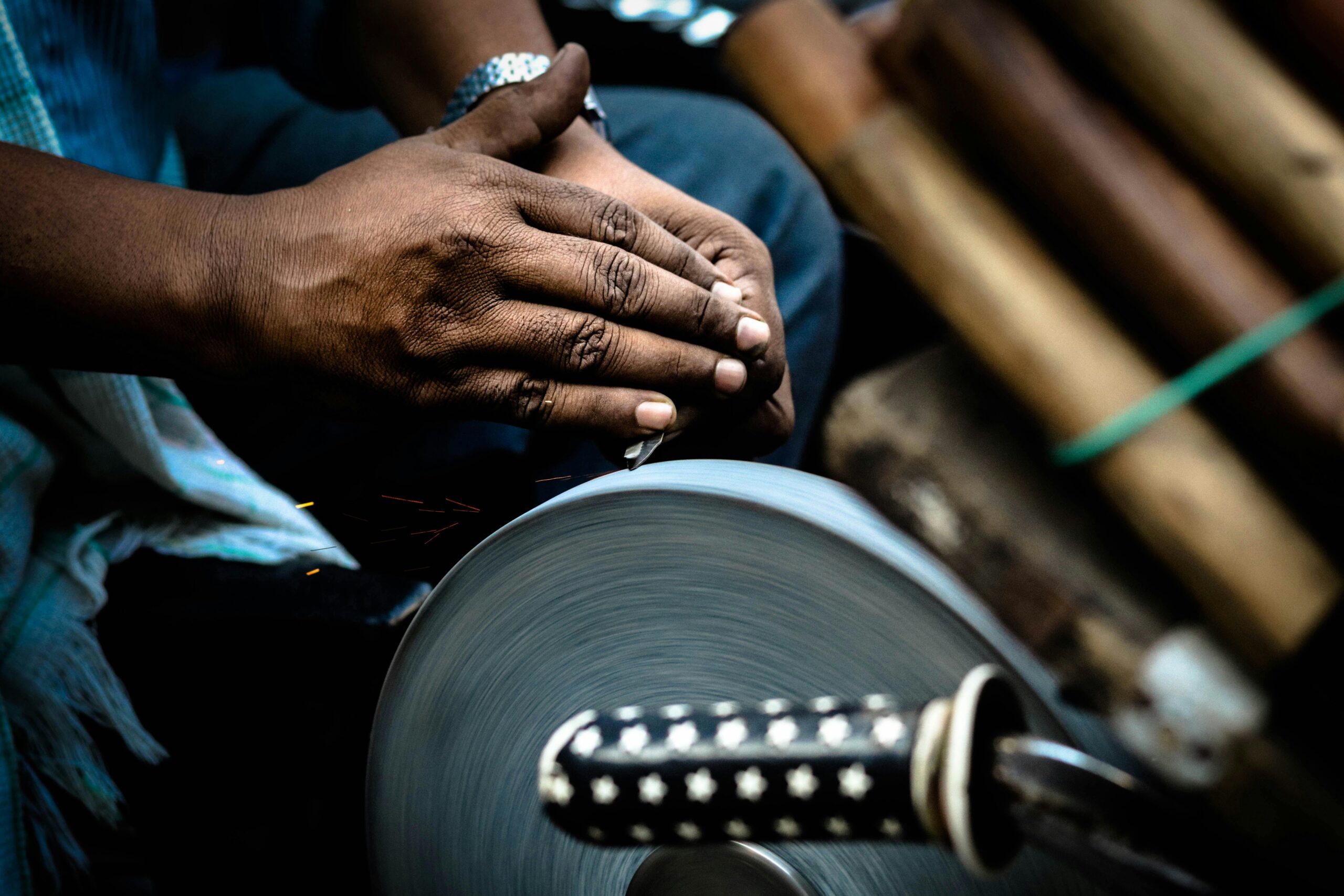How to sharpen a knife is very important issue for every kitchen. Our comprehensive guide covers essential techniques, tools, and tips to achieve a razor-sharp edge. Ensure safety, efficiency, and longevity for your blades with expert advice for beginners and advanced sharpeners alike.
Keeping your knife sharp is essential for efficient and safe cutting in the kitchen. Sharp knives not only make your cooking experience smoother but also reduce the risk of accidents. In this comprehensive guide, we will walk you through the various methods of knife sharpening, the tools required, and best practices to ensure your knives remain in optimal condition.
Table of Contents
Introduction
A sharp knife is an essential tool in any kitchen, workshop, or toolbox. Whether you’re a professional chef, a home cook, or a handyman, having a well-sharpened knife makes your work safer, more efficient, and more enjoyable. This comprehensive guide will walk you through everything you need to know about knife sharpening, including the different methods, tools, and techniques to achieve the perfect edge on your blades.
Why Sharpening Your Knife is Important
Safety
A sharp knife is safer. It may sound counterintuitive, but a sharp blade requires less force to cut through materials, reducing the likelihood of slipping and causing accidental injuries.
Efficiency
Sharp knives make tasks easier and faster. Whether you’re slicing vegetables, carving meat, or whittling wood, a sharp blade performs the job with precision and ease.
Longevity
Regular sharpening extends the life of your knives. By maintaining a sharp edge, you reduce the wear and tear on the blade, preventing unnecessary damage and prolonging its usability.
Understanding Knife Anatomy
Before diving into the sharpening process, it’s important to understand the basic anatomy of a knife. This knowledge will help you identify the areas that need attention and ensure you achieve the best results.
Blade
The blade is the main cutting part of the knife. It consists of several sections, including:
Edge: The sharpened part of the blade that does the cutting.
Spine: It provides strength and stability.
Tip: The pointed end of the blade, used for detailed cutting.
Heel: The rear part of the blade, near the handle. It’s useful for cutting tasks that require more force.
Handle
The handle provides grip and control. It can be made from various materials, including wood, plastic, and metal. A good handle should be comfortable and secure.
Tang
A full tang, which runs the entire length of the handle, offers better balance and strength.
Types of Knife Edges
Different knives have different edge types, each requiring specific sharpening techniques. The most common edge types include:
V-Edge (Double Bevel)
This is the most common type of edge, found on kitchen knives and many utility knives. It features two bevels that form a “V” shape. V-edges are relatively easy to sharpen and maintain.
Convex Edge
A convex edge is rounded rather than straight, providing a robust and durable cutting surface. It’s commonly found on heavy-duty knives like axes and survival knives.
Hollow Grind
A hollow grind features a concave shape, creating a thin, razor-sharp edge. It’s often used on straight razors and some kitchen knives.
Scandi Grind
Also known as a single bevel or Scandinavian grind, this edge type has a single, wide bevel. It’s popular on woodworking and bushcraft knives for its ease of sharpening and precision cutting.
Sharpening Methods: How to Sharpen a Knife
There are several methods to sharpen a knife, each with its own set of tools and techniques. The best method for you will depend on your experience level, the type of knife, and your personal preference. The methods of how to sharpen knife are given below:
Whetstones
Whetstones, also known as sharpening stones, are one of the most traditional and effective ways to sharpen a knife. They come in various grits, from coarse to fine, allowing you to shape and refine the edge.
How to Sharpen a Knife with a stone:
- Soak the Stone: If you’re using a water stone, soak it in water for 10-15 minutes before use. Oil stones should be lubricated with honing oil.
- Position the Stone: Place the stone on a non-slip surface or a dedicated stone holder to keep it stable.
- Find the Angle: Hold the knife at the correct sharpening angle, usually around 20 degrees for kitchen knives. Some whetstones come with angle guides to assist with this.
- Sharpen the Blade: Using even pressure, slide the blade across the stone in a sweeping motion, maintaining the angle. Repeat on both sides of the blade until you achieve a sharp edge.
- Refine the Edge: Switch to a finer grit stone to polish and refine the edge. This step is crucial for achieving a razor-sharp finish.
- Test the Sharpness: Carefully test the sharpness by slicing through a piece of paper or gently running your thumb across the edge (without touching it directly).
Honing Rods
Honing rods, also known as sharpening steels, are used to maintain the edge of a knife between sharpening sessions. They don’t remove metal but realign the edge to keep it sharp.
Steps to Use a Honing Rod:
- Hold the Rod: Hold the honing rod vertically with the tip resting on a stable surface.
- Position the Knife: Hold the knife at a 20-degree angle to the rod.
- Hone the Blade: Draw the blade down the rod in a sweeping motion, alternating sides. Repeat this process 5-10 times per side.
- Test the Sharpness: Check the sharpness of the blade to ensure it’s been properly honed.
Electric Sharpeners
Electric sharpeners offer a quick and convenient way to sharpen knives. They usually come with pre-set angles and multiple stages for coarse grinding and fine honing.
Steps to Use an Electric Sharpener:
- Read the Manual: Follow the manufacturer’s instructions for your specific model.
- Insert the Knife: Place the blade into the sharpening slot and pull it through, following the machine’s guides.
- Repeat as Needed: Depending on the sharpener, you may need to repeat the process in different slots for a finer edge.
- Test the Sharpness: Evaluate the sharpness of the blade and repeat the process if necessary.
Sharpening Systems
Sharpening systems combine the precision of whetstones with the convenience of guided angles. They often include multiple stones or diamond plates and an adjustable guide to ensure consistent results.
Steps to Use a Sharpening System:
- Set Up the System: Assemble the system according to the manufacturer’s instructions.
- Attach the Knife: Secure the knife in the clamp or holder.
- Adjust the Angle: Set the sharpening angle using the system’s guide.
- Sharpen the Blade: Use the stones or plates to sharpen the blade, following the guide’s path.
- Test the Sharpness: Check the blade’s sharpness and adjust the angle or stones as needed.
Knife Maintenance Tips
Knife maintenance tips are given below:
Cleaning
Always clean your knives after use to prevent food residue and moisture from damaging the blade. Hand wash with warm, soapy water and dry immediately.
Storage
Avoid storing knives loose in a drawer, as this can cause damage.
Regular Honing
Use a honing rod regularly to maintain the edge between sharpening sessions. This will help prolong the time between full sharpening.
Avoiding Hard Surfaces
Cutting on hard surfaces like glass, stone, or metal can dull your knife quickly.
Proper Use
Use your knives for their intended purpose. Avoid using them to cut hard materials like bones, frozen foods, or as a screwdriver or pry bar.
Troubleshooting Common Sharpening Issues
Even with the best techniques, you may encounter some common issues while sharpening your knives. Here’s how to troubleshoot them:
Uneven Edge
An uneven edge can result from inconsistent pressure or angle while sharpening. To fix this, focus on maintaining a consistent angle and pressure throughout the process.
Burr Formation
A burr is a thin, raised edge of metal that forms during sharpening. It’s a sign that the edge is being sharpened but needs to be removed for a clean finish. Use a finer grit stone or a honing rod to remove the burr.
Dull Spots
Dull spots can occur if certain areas of the blade are not being sharpened evenly. Pay extra attention to these areas, ensuring consistent contact with the stone or sharpening tool.
Chipping
Chipping can result from using a blade that is too hard or from improper sharpening techniques. If your knife chips, try using a coarser stone to remove the damaged edge and then refine it with finer stones.
Advanced Sharpening Techniques
For those looking to take their sharpening skills to the next level, here are some advanced techniques:
Mirror Polishing
Mirror polishing involves using very fine grit stones or polishing compounds to achieve a mirror-like finish on the edge. This technique is often used for straight razors and high-end kitchen knives.
Convex Sharpening
Convex sharpening requires a special technique to create a rounded edge. It’s typically done with a slack belt sander or by freehand sharpening with a rolling motion on a whetstone.
Reprofiling
Reprofiling involves changing the angle or shape of the blade edge. This technique is useful for customizing the performance of a knife or repairing significant damage. It requires coarse stones and careful attention to detail.
Conclusion
Sharpening a knife is a valuable skill that can enhance your cooking, woodworking, and overall tool performance. By understanding the different methods, tools, and techniques, you can achieve a razor-sharp edge on your knives and maintain them for years to come. Whether you prefer the traditional approach of whetstones or the convenience of electric sharpeners, the key is to practice and find what works best for you.
FAQs
1. Why is it important to sharpen a knife?
Sharpening a knife is crucial for safety, efficiency, and maintaining the longevity of the blade. A sharp knife requires less force, reducing the risk of slipping and causing injury, and ensures precise and effortless cutting.
2. How often should I sharpen my knife?
The frequency of sharpening depends on the knife’s use. For regular kitchen use, honing the knife with a rod every few uses and sharpening it with a whetstone or electric sharpener every few months is recommended. Professional chefs might sharpen their knives weekly.
3. What is the best angle to sharpen a knife?
The ideal sharpening angle depends on the knife type. For most kitchen knives, a 15-20 degree angle is optimal. For outdoor and utility knives, a 20-25 degree angle provides more durability.
4. What’s the difference between honing and sharpening?
Honing realigns the edge of the knife, keeping it sharp between sharpening sessions. Sharpening involves grinding away material to create a new edge, restoring the blade’s sharpness.
5. Can I sharpen a serrated knife?
Yes, but it’s more challenging than sharpening a straight-edged. Use a specially designed serrated sharpener or a ceramic rod to individually sharpen each serration.
6. Do I need a different sharpener for different knives?
Different knives might benefit from specific sharpeners. Whetstones are versatile for most of them, while serrated knives require specialized sharpeners. Electric sharpeners often come with settings for various knife types.
7. What grit of whetstone should I use?
Start with a coarse grit (200-600) for dull knives or repairing damage. Use medium grit (800-2000) for general sharpening, and finish with a fine grit (3000-8000) for polishing and achieving a razor-sharp edge.
8. Can I use a knife sharpener on ceramic knives?
Most standard sharpeners are not suitable for ceramic knives due to their hardness and brittleness. Use a diamond sharpener specifically designed for ceramic blades.
9. Why does my knife still feel dull after sharpening?
If your knife feels dull after sharpening, you might not have maintained a consistent angle, applied uneven pressure, or fully removed the burr. Ensure proper technique and consider using a finer grit stone or honing rod.
10. What is a burr, and how do I remove it?
A burr is a small, raised edge of metal formed during sharpening. Remove it by using a finer grit stone or honing rod, gently stroking the blade at a consistent angle to smooth the edge.
11. Can I sharpen with household items?
In emergencies, you can use the unglazed bottom of a ceramic mug or a smooth stone. However, these methods are not recommended for regular use as they can damage.
12. Is it worth getting a professional knife sharpener?
If you have high-quality knives or lack confidence in your sharpening skills, professional sharpening can ensure optimal results and extend the life of your blades.
13. How do I test the sharpness of my knife?
Test the sharpness by slicing through a piece of paper or gently running your thumb across the edge (without touching it directly). A sharp knife should easily cut through paper and feel smooth.
14. What are common mistakes to avoid when sharpening a knife?
Common mistakes include using the wrong angle, applying uneven pressure, not using a lubricant on the stone, and neglecting to hone regularly. Practice and proper technique are key to effective sharpening.



